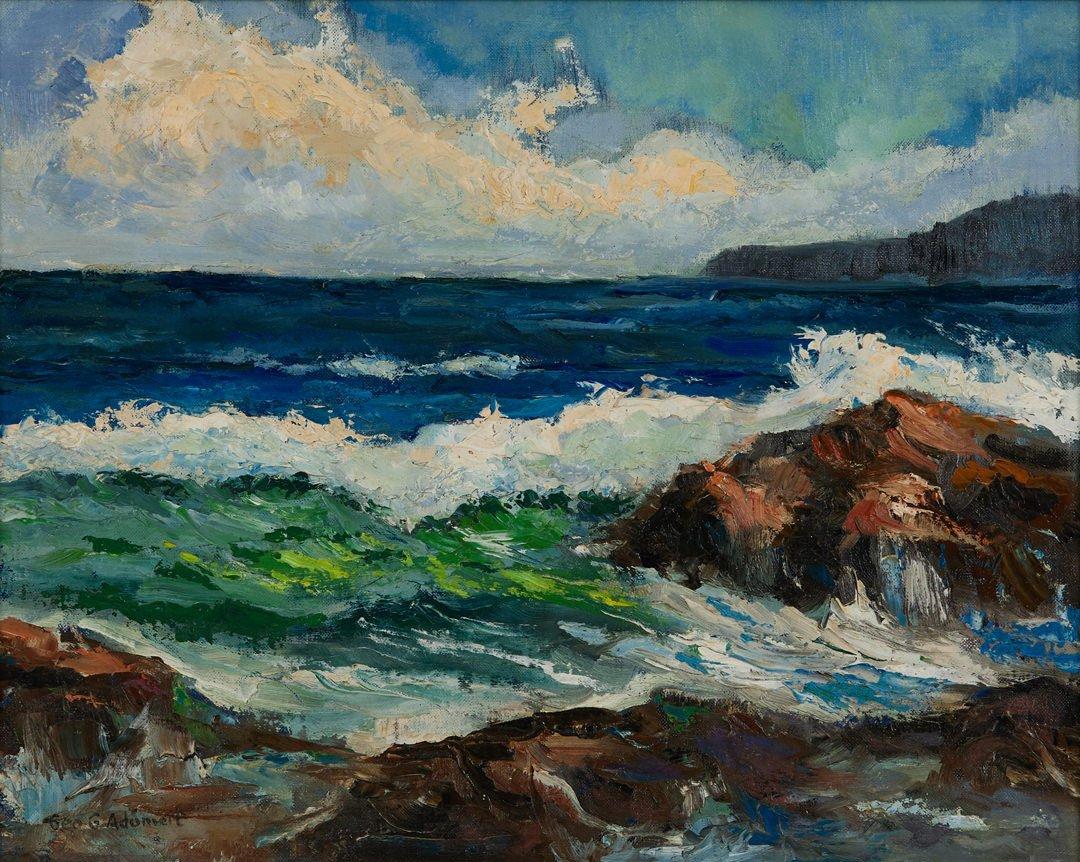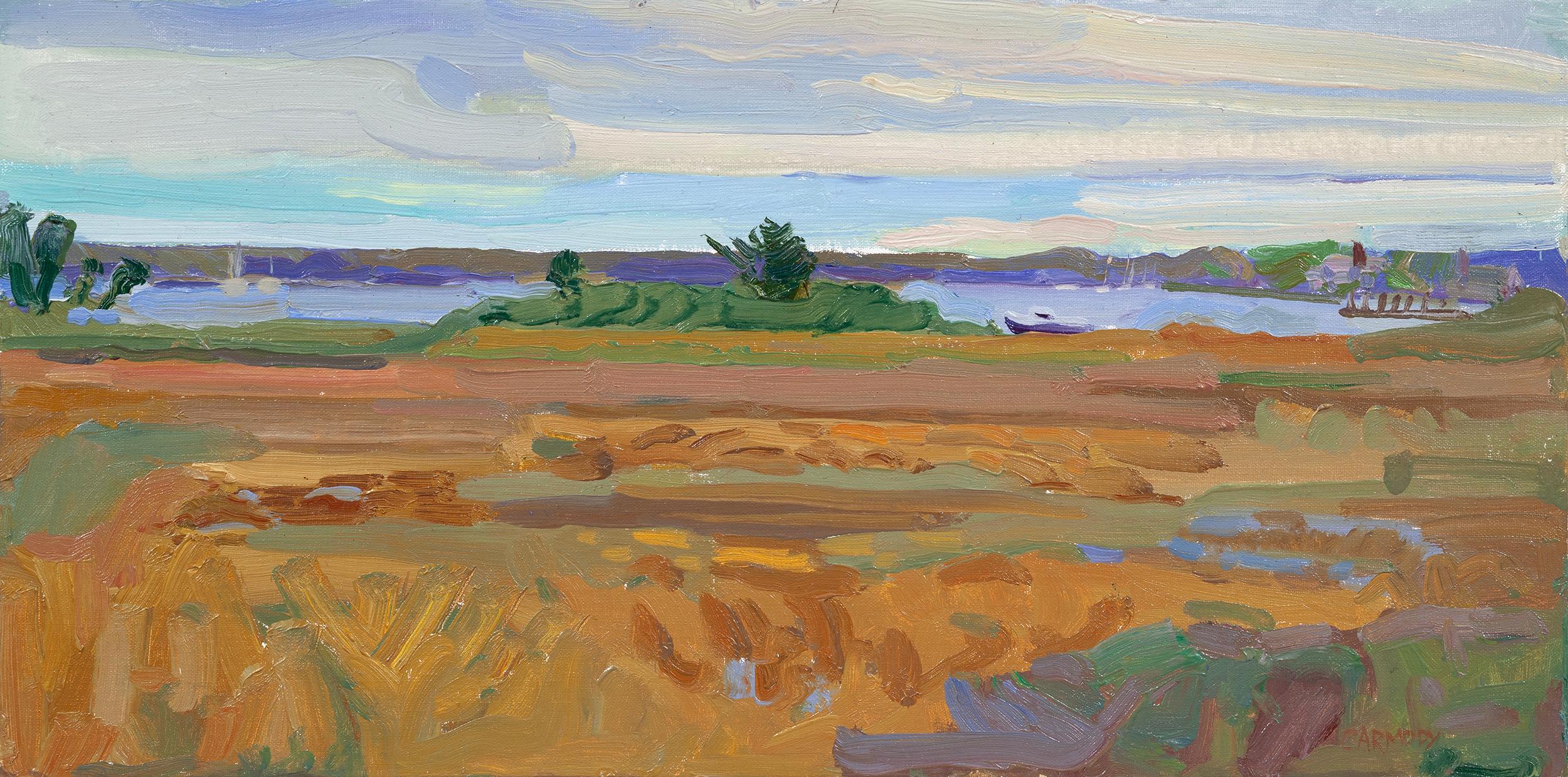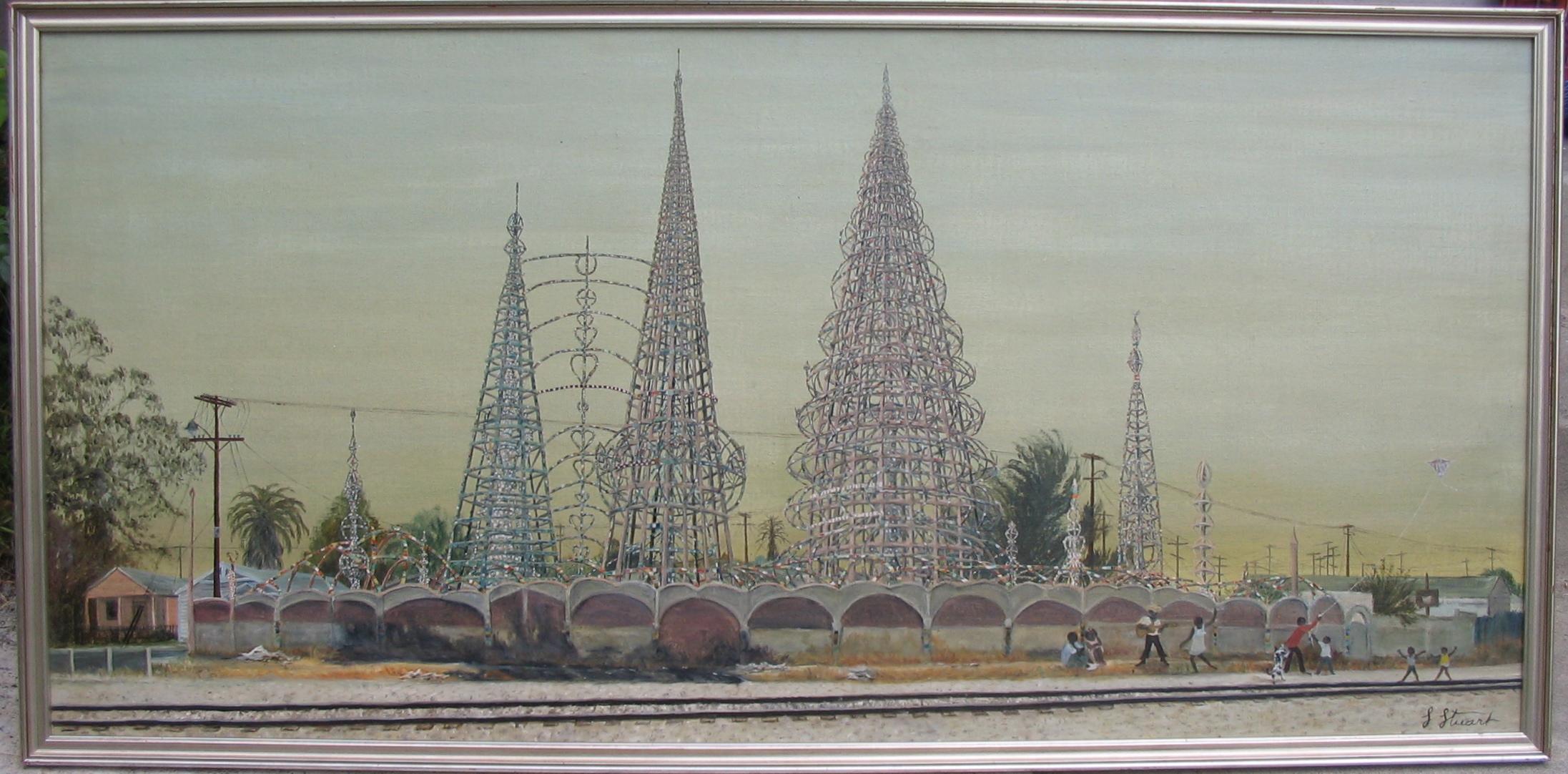Edward MarecakAutumn Harvest, Original Semi-Abstract Landscape and Figurative Oil Painting 1987
1987
About the Item
- Creator:Edward Marecak (1919 - 1993)
- Creation Year:1987
- Dimensions:Height: 49.58 in (125.94 cm)Width: 33.25 in (84.46 cm)Depth: 1.5 in (3.81 cm)
- Medium:
- Movement & Style:
- Period:
- Framing:Frame IncludedFraming Options Available
- Condition:
- Gallery Location:Denver, CO
- Reference Number:
Edward Marecak
Edward Marecak was an American painter who was born in 1919. Growing up in the farming community of Brunswick, Ohio, he showed early artistic promise, hired by the National Youth Administration to document historic barns. In 1946, Marecak came to the Colorado Springs Fine Arts Center for a year and after a semester interlude at Cranbrook returned to study lithography with Lawrence Barrett. There he also met his future wife and sometime collaborator, ceramicist Theresa Madonna Fortin. Given the opportunity to teach a summer course at the University of Colorado, he decided to obtain a teaching certificate at the University of Denver and subsequently embarked on his 25-year career in the Denver Public School system. Rather than pursue fame, Edward Marecak directed his zeal toward fostering younger generations in the principles of art as well as his simple philosophies. Moreover, his teaching salary allowed him to ply his prodigious talent at whatever he pleased, instead of bending to the dictates of trends and sales. Having inherited his faith in education from his Slovakian immigrant parents, Marecak could add the shaping of lives to his mastery of art forms, including lithographs, monoprints, drawings, hooked rugs, ceramics, paintings, wood sculptures, stained-glass windows and jewelry. While exhibiting in his lifetime, he was, in his wife’s words, “his own greatest collector”, but shows and his popularity at the Kirkland Museum have positioned Marecak posthumously among Colorado’s pre-eminent modernists. As a child, Marecak was enthralled by the Carpathian tales of magic and supernatural beings told by his grandmother. As with other artists with roots in Eastern Europe, his artistic turn to folk tradition would free him from learned practices of perspective and modeling in favor of flat patterns within patterns and brilliant, throbbing color. While others ventured further into abstraction, Marecak stylized figurative elements into crowded compositions that appeared like a mosaic or stained glass. As he matured, he could declare, “I am still very much a Byzantine designer and my joy with what color can do grows all the time”. The traceries of strong outlines and bold shapes provide compartments for vibrant colors, contrasts and rough textures that can scarcely be contained. The Kirkland Museum staged a retrospective of Edward and Donna Marecak in 2007.
- ShippingRetrieving quote...Ships From: Denver, CO
- Return PolicyA return for this item may be initiated within 7 days of delivery.
- City Park, Denver, Colorado, Large Semi Abstract Colorful Oil LandscapeBy Edward MarecakLocated in Denver, COLarge format oil painting on canvas of City Park in Denver, Colorado by 20th century Denver modernist, Edward Marecak. Semi-abstract park scene with various types of trees, figures, ...Category
20th Century American Modern Landscape Paintings
MaterialsOil, Canvas
- Colorado Hill Town with Storm Clouds, 1940s Modernist Landscape, Green BlueBy Paul Kauver SmithLocated in Denver, COWPA era signed framed modernist oil painting of houses and trees in summer with a stormy cloud in Colorado by Paul K. Smith in shades of green, ...Category
1940s American Modern Landscape Paintings
MaterialsOil
- In Soquel, California, 1950s Farm Landscape with Silo, Blue, Green, Gold, GrayBy Jon BlanchetteLocated in Denver, CO"In Soquel (California)" is an original oil on board painting by Jon Blanchette (1908-1987) circa 1955. Farm landscape with figure hanging laundry and silo, painted in colors of blue...Category
1950s American Modern Landscape Paintings
MaterialsOil, Board
- Adobe Church, New Mexico, 1940s Modernist Southwestern Landscape Oil PaintingBy Paul Kauvar SmithLocated in Denver, COVintage 1930s - 1940s oil painting of an adobe church in New Mexico with a brilliant blue sky and clouds (likely Rancho de Taos), circa 1940. Painted by Denver modernist, Paul K...Category
1940s American Modern Landscape Paintings
MaterialsCanvas, Oil
- Homesteaders, 1960s Framed Colorado Mountain Landscape Oil PaintingBy Harold Vincent SkeneLocated in Denver, CO"Homesteaders" is an original oil on board painting by artist Harold Vincent Skene (1883-1978) painted in 1960. The painting depicts two figures plowing a field with a pair of oxen, ...Category
1960s American Modern Landscape Paintings
MaterialsOil, Board
- Native American Figures at Taos Pueblo, New Mexico Southwestern Oil PaintingLocated in Denver, COOriginal 20th century oil painting by Wolfgang Pogzeba (1936-1982) with Native American figures standing in bright blankets with adobe buildings in th...Category
Mid-20th Century American Modern Figurative Paintings
MaterialsOil, Canvas
- Coastal Scene, 20th Century Seascape, Cleveland School ArtistBy George AdomeitLocated in Beachwood, OHGeorge Gustav Adomeit (American, 1879-1967) Coastal Scene Oil on canvas Signed lower left 19 x 23 inches 21.5 x 25.5 inches, framed A major painter of American scene subjects, Georg...Category
20th Century American Modern Figurative Paintings
MaterialsOil
- "Looking Out" contemporary seascape with young woman in whiteBy Kelly CarmodyLocated in Sag Harbor, NY"Looking Out" is a contemporary seascape with a young woman in white admiring the view. Framed dimensions: 14 x 24 inches Kelly Carmody’s work has been widely exhibited and collect...Category
21st Century and Contemporary American Modern Figurative Paintings
MaterialsOil, Panel, Board, Linen
- "Ram Island Drive" earth toned contemporary oil painting by Kelly CarmodyBy Kelly CarmodyLocated in Sag Harbor, NY"Ram Island Drive" is an earth toned contemporary oil painting by Kelly Carmody. framed dimensions: 14 x 24 inches Kelly Carmody’s work has been widely exhibited and collected. One...Category
21st Century and Contemporary American Modern Figurative Paintings
MaterialsPanel, Linen, Oil
- WATTS TOWERBy Gloria StuartLocated in Santa Monica, CAGLORIA STUART (1910 – 2010) WATTS TOWERS, 1971 Oil on canvas, signed lower right, 24” x 50 ½”. Gloria Stuart, an Academy Award nominated actress was also a painter, illustrator and printmaker. She most recently portrayed Rose in the blockbuster film “Titanic”. She was a Santa Monica native. In 2013 The Los Angeles Museum of Art, LACMA exhibited a nearly identical painting looking from the south, the same size and frame. Last 5 photos show the example at LACMA. One shows theirs in a distant room with a major Thomas Hart Benton painting in the foreground A VERY IMPORTANT MULTI-LEVELED DOCUMENT OF LOS ANGELES AND HOLLYWOOD CULTURAL HSTORYi The following is from her obituary in the Los Angeles Times upon her death in September 2010 at the age of 100 Gloria Stuart, a 1930s Hollywood leading lady who earned an Academy Award nomination for her first significant role in nearly 60 years — as Old Rose, the centenarian survivor of the Titanic in James Cameron’s 1997 Oscar-winning film — has died. She was 100. .......She devoted much of her time to designing and printing artists’ books (handmade, letter-press printed books in limited editions, with her own artwork and writing). Her work is in the J. Paul Getty Museum in Los Angeles, the Metropolitan Museum of Art in New York City, the Victoria and Albert Museum in London and other museums. Stuart, a founding member of the Screen Actors Guild who later became an accomplished painter and fine printer, died Sunday night at her West Los Angeles home, said her daughter, writer Sylvia Thompson. Stuart had been diagnosed with lung cancer five years ago. “She also was a breast cancer survivor,” Thompson said, “but she just paid no attention to illness. She was a very strong woman and had other fish to fry.” In July the actress was honored at an “Academy Centennial Celebration With Gloria Stuart” at the Samuel Goldwyn Theater in Beverly Hills. “She was a charming and beautiful leading lady in the ‘30s, and I never understood why her career didn’t go further at that time,” film historian and critic Leonard Maltin, who interviewed Stuart on stage at the event, told The Times on Monday. As for Stuart’s high-profile comeback in “Titanic”: “She was thrilled by the attention that that performance brought her and really wanted to win that Oscar. I thought she hit just the right notes in that performance. She was wry and engaging.” As a glamorous blond actress under contract to Universal Studios and 20th Century Fox in the 1930s, Stuart appeared opposite Claude Rains in James Whale’s “The Invisible Man” and with Warner Baxter in John Ford’s “The Prisoner of Shark Island.” She also appeared with Eddie Cantor in “Roman Scandals,” with Dick Powell in Busby Berkeley’s “Gold Diggers of 1935” and with James Cagney in “Here Comes the Navy.” And she played romantic leads in two Shirley Temple movies, “Poor Little Rich Girl” and “Rebecca of Sunnybrook Farm.” But mostly she played what Stuart later dismissed as “stupid parts with nothing to do” — “girl reporter, girl detective, girl nurse” — and “it became increasingly evident to me I wasn’t going to get to be a big star like Katharine Hepburn and Loretta Young.” After making 42 feature films between 1932 and 1939, Stuart’s latest studio contract, with 20th Century Fox, was not renewed. She appeared in only four films in the 1940s and retired from the screen in 1946. By 1974, “the blond lovely of the talkies” had become an entry in one of Richard Lamparski’s “Whatever Happened to” books. Writer-director Cameron’s $200-million “Titanic” changed that. Stuart played Rose Calvert, the 100-year-old Titanic survivor who shows up after modern-day treasure hunters searching through the wreckage of the sunken ship find a charcoal drawing of her wearing a priceless blue diamond necklace. Stuart’s performance as Old Rose frames the 1997 romantic- drama that starred Leonardo DiCaprio as lower-class artist Jack Dawson...Category
1970s American Modern Landscape Paintings
MaterialsOil
- Spring , Modernist Native American Ceremonial Scene and Cultural CommentaryLocated in Doylestown, PA"Spring" is a 25 x 30 inches, oil on canvas painting by American modernist and surrealist, female artist Peter Miller. The work is signed and titled on verso, and painted in a vibran...Category
1940s American Modern Landscape Paintings
MaterialsCanvas, Oil
- Large Modernist Oil Painting 1940s, Judaica Hasidic Shtetl Wagon Driver WPA EraBy Emanuel Glicenstein RomanoLocated in Surfside, FLGenre: Modern Subject: Landscape with figure of horse, driver and wagon Medium: Oil Surface: wood Board EMANUEL ROMANO Rome, Italy, b. 1897, d. 1984 Emanuel Glicen Romano was born in Rome, September 23, 1897. His father Henryk Glicenstein was a sculptor and was living in Rome with his wife Helena (born Hirszenberg) when Emanuel was born. His father obtained Italian citizenship and adopted the name Enrico. Emanuel was brought up in Italy, Switzerland, Germany, England and Poland. In 1926 Emanuel Glicenstein Romano and his father sailed for New York. They briefly visited Chicago. Romano's sister, Beatrice, and mother only joined them in New York years later. Romano changed his name on his arrival to America and some have erroneously speculated that this was to avoid antisemitic discrimination. In truth, as the son of a highly-regarded artist, Romano changed his name to ensure that any success or recognition he would later attain, would be the result of nothing other than his own merit as an artist, and not on account of his father's fame. In 1936 Romano was worked for the WPA Federal Art Project creating murals. ( there were many jewish artists active with in the WPA period. notably Chaim Gross, Ben Shahn, Isaac and Moses Soyer, Abraham Rattner and many others. During and immediately after World War II, Romano created a series of allegorical works depicting graphic holocaust images that were held closely by the family until after his passing. One of these works is now on permanent display in the Florida Holocaust Museum in St. Petersburg Florida. Emanuel's father died in 1942 in a car accident before they could realize their shared dream of visiting Israel. In 1944 Romano, having completed his degree at the Pennsylvania Academy of Fine Arts and the Art Institute of Chicago, began teaching at the City College of New York. Romano moved to Safed, Israel in 1953 and established an art museum in his father's memory, the Glicenstein Museum. COLLECTIONS Indianapolis Museum of Art Metropolitan Museum of Art Boston Fine Arts Museum Fogg Museum Musée Nacional de France Recently his work has been added to the Florida Holocaust Museum collection. His notable works include his holocaust themed allegorical paintings as well as portraits of Marianne Moore, his father and William Carlos Williams...Category
1930s American Modern Figurative Paintings
MaterialsOil, Board





